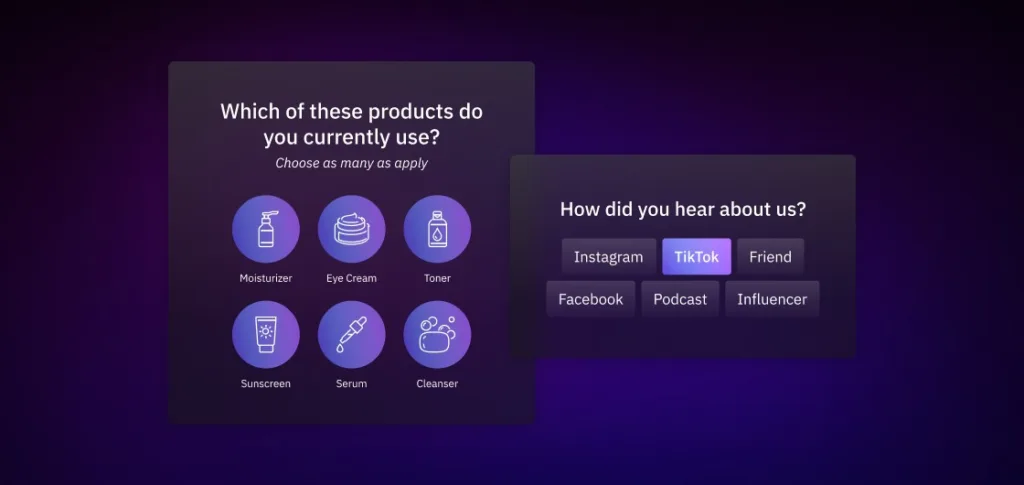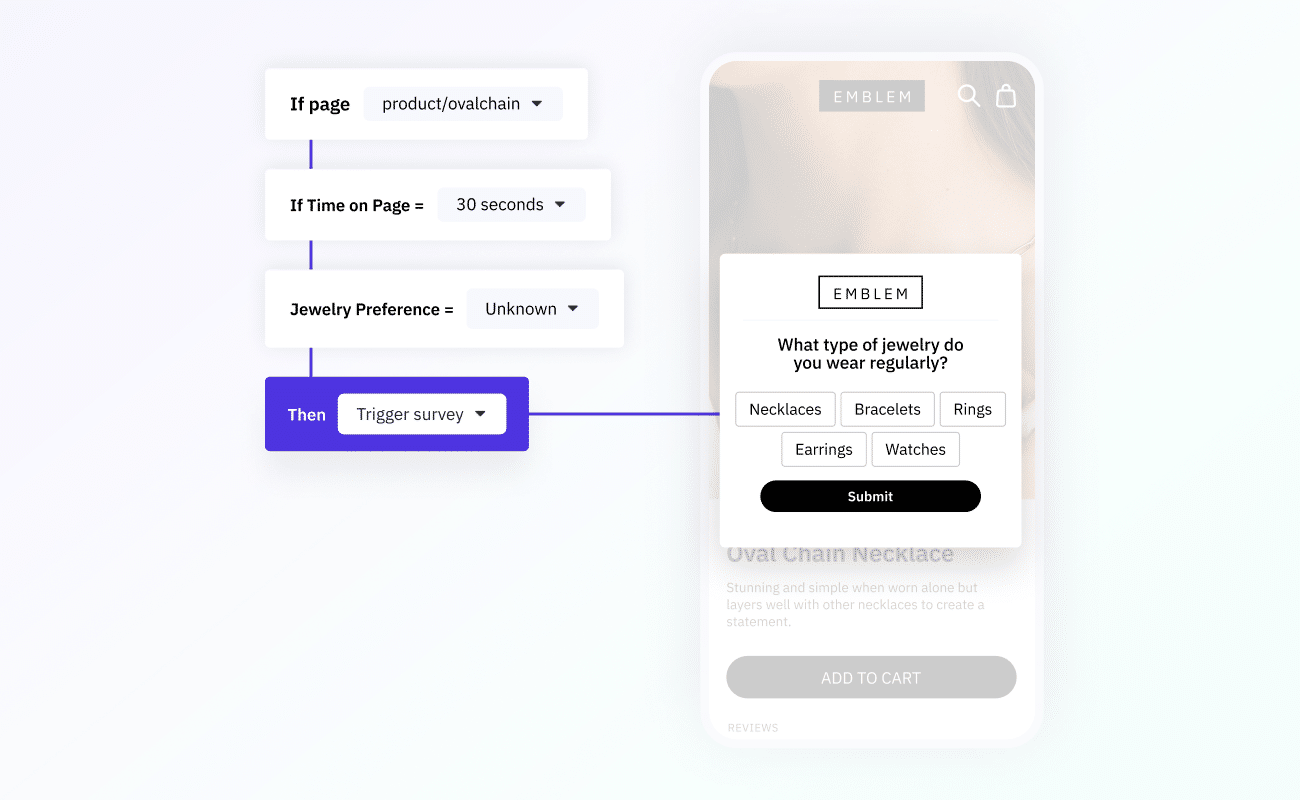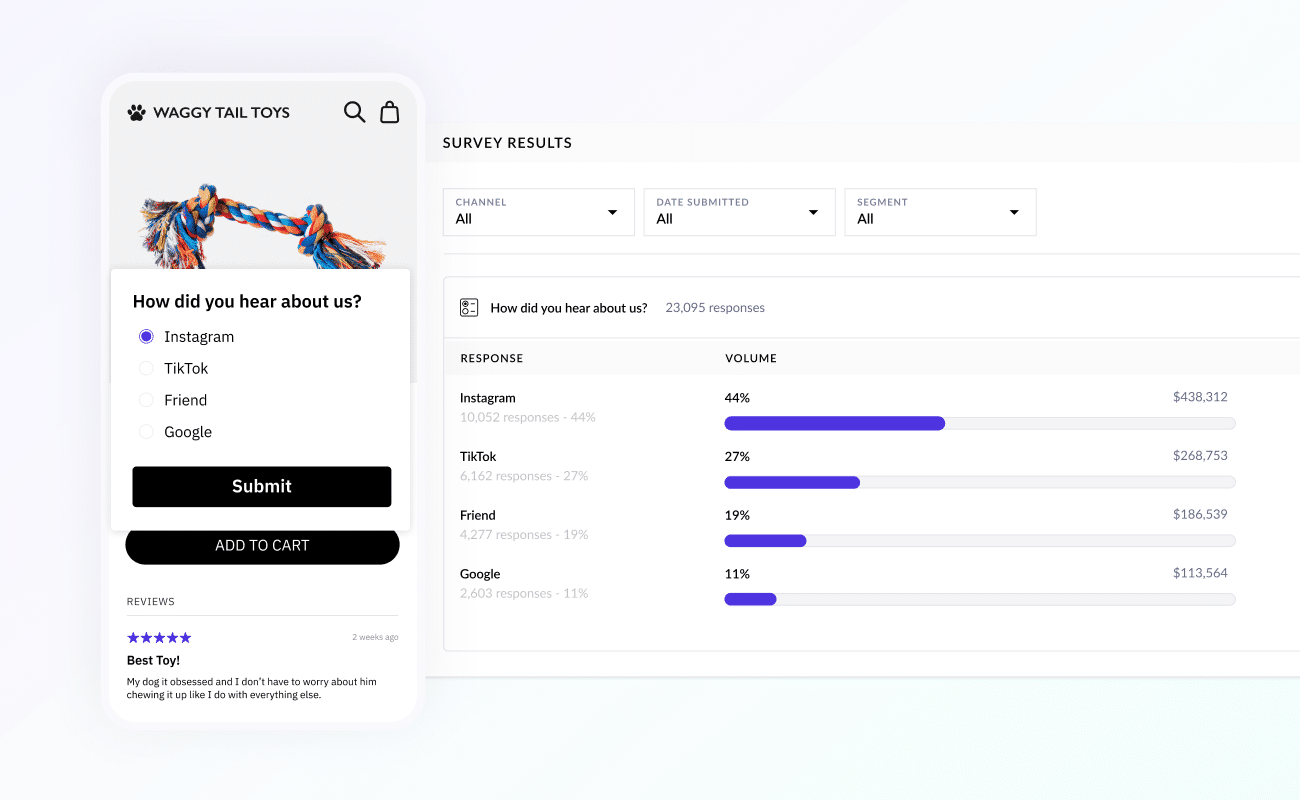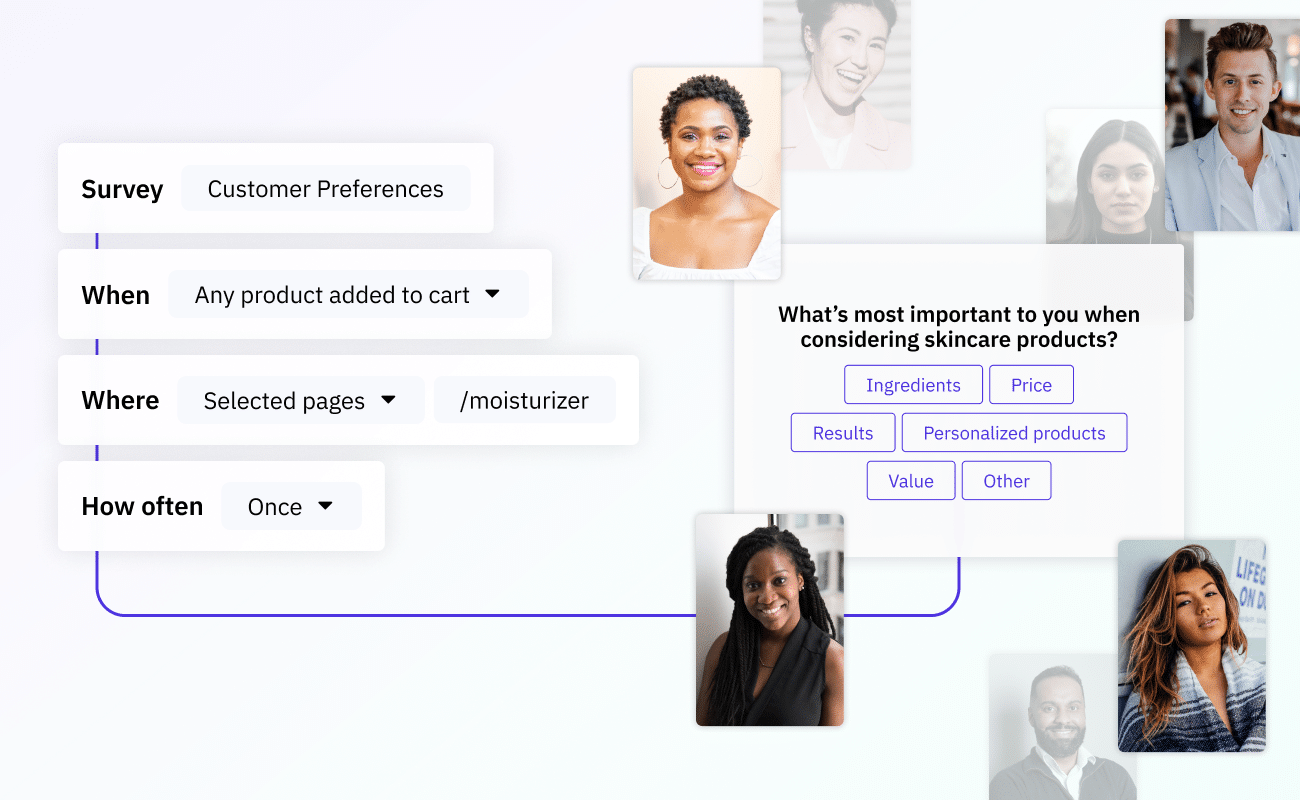
- Customer Marketing
- Quizzes
- Superfans
- Surveys
Surveys vs. Quizzes: How to Use Both in a Unified Customer Marketing Strategy
Megan Wenzl | Jan 30, 2024
May 16, 2023 | 9 minute read

Megan Wenzl
Content Marketing Manager
Experiencing rapid growth is both an exciting and pivotal moment for any Shopify brand. To watch orders flow in as your product gains traction amongst consumers can be exhilarating, but it also often comes with a distinct sense of pressure to ensure that the growth of your business is sustainable in the long run. For example, how do you continue to differentiate yourself from other brands, including large and increasingly dominant ecommerce marketplaces? Are you doing everything you can to turn those first-time shoppers into loyal customers and vocal advocates for your brand?
This is where tools like customer surveys come in; by gaining the ability to collect and utilize customer feedback in a variety of contexts, you can significantly improve experiences, increase conversions, and generate the actionable insights needed to build and increase customer advocacy over time.
However, in order to leverage surveys effectively, you’ll need to choose a platform provider that understands how to optimize the process, and provides all the features needed to truly maximize the positive impacts of customer surveys on your brand. While evaluating and choosing the right platform might seem like a daunting task, there are a series of questions you can ask that will help you identify your best option.
The first thing to keep in mind is that an optimal survey platform should do more than provide the ability to ask customers for feedback. It should help you establish a process that allows you to gather actionable customer insights continuously and across virtually all touchpoints in the buyer’s journey.
But what would such a process look like? For starters, it won’t include the use of traditional, long-form surveys, which simply aren’t built to meet the evolving needs and expectations of modern consumers. The fact is that traditional surveys are often friction-filled, conducted out of context, and delivered days or sometimes even weeks after a purchase has been made.
This is why the most effective platforms utilize micro-surveys, or short-form questionnaires that very rarely consist of more than 1-3 highly relevant questions. This allows customers to respond effortlessly throughout all stages of their buying journey, improving their experience while providing your brand with access to actionable feedback in real-time.
As Mike Wargent, Founder, Orange Creative Co., says, “The ability to trigger micro-surveys, based on the actions of shoppers on your website, is crucial for merchants to deliver positive customer experiences today. Consumers want simple surveys that take minimal time and are easy to fill out. These short surveys allow merchants to get the real-time data they need from customers to create personalized marketing and experiences.” 
Moreover, an optimal survey platform will offer multiple avenues of distribution that make it easier for customers to respond without feeling inconvenienced. This means surveys can be both displayed on-site and delivered via shareable links in email, SMS, and social media communications, and always in the appropriate context.
For example, including a link to a short survey to customers who abandoned their cart will allow you to understand why a customer left, and most importantly to utilize the feedback to improve customer experiences going forward.
In addition to limiting when surveys are delivered, many platforms will also limit the specific type of survey that can be utilized. For example, many survey platforms prioritize the optimization of Net Promoter Score (NPS) surveys, which measure the likelihood of a customer recommendation, and marketing attribution or “How Did You Hear About Us?” (HDYHAU) surveys, which allow you to gauge the effectiveness of different marketing channels.
Although NPS and HDYHAU surveys are absolutely critical, they don’t allow you to dig deeper and gain additional insights that benefit personalization and improve customer experiences at a variety of levels. Here’s a break down of the different survey types an ideal survey platform will offer to allow you to take a much more holistic approach to data collection and analysis:
Marketing Attribution:
Market attribution surveys allow you to collect insights from customers right after they make a purchase, allowing you to measure the true ROI of your marketing campaigns. In turn, you’ll be able to know where to put more dollars into a campaign and what campaigns to cut back on based on HDYHAU attribution.

Zero-Party Data:
Micro-surveys can be placed strategically across your site and in email and SMS campaigns to collect actionable zero-party data including demographic information, behavioral trends, and preferences which can be used to consistently improve targeting strategies and considerably lower customer acquisition costs over time.
Collecting zero-party data makes it easier to group your customers into segments based on behaviors and preferences, and target those segments accordingly with personalized communications and promotional offers.
Market Research:
As an ecommerce brand, it’s crucial to deploy surveys that help optimize your market research efforts, revealing consumer trends and behaviors, as well as keeping you up to date with the competitive landscape. For example, market research helps you understand what products you should offer and how to market these products successfully.
NPS surveys are critical for you to understand how likely a customer is to recommend your product to a friend as well as customer loyalty. In today’s environment where customers have an endless array of companies to choose from, the ability to measure these areas is imperative.
It’s not uncommon for Shopify brands and their survey providers to limit their efforts to just one touchpoint in the buyer’s journey. If you’re only gauging levels of satisfaction at post-checkout, for example, you’re missing a variety of opportunities to learn more about your customer at different stages, and ultimately to optimize their purchasing experience from end to end.
Rather than zeroing in on one or two stages, an ideal survey platform will allow you to gather feedback across all touchpoints in the entire journey. You should be able to send a survey by shareable link through channels such as SMS, email, or social media. In addition, the option to send a survey post-review, post-purchase, and on your website are must-have features in any survey platform.

Focusing on a combination of these two components as it relates to each step in the buyer’s journey provides the depth of insights necessary to address customer pain points efficiently, while ensuring positive experiences no matter where or when a customer interacts with your brand.
Modern consumers have an increasing appetite for personalized experiences, and in fact our own ecommerce research found that nearly 80% of online shoppers consider personalization to be a critical component of their overall shopping experience.
For this reason, it’s crucial to choose a survey provider that allows you to target specific audiences with specific types of questions.
For example, if you’re a coffee company that sells both cold brew and ground coffee products, you might ask your customers how they like their coffee to be prepared. This will allow you to follow up immediately with individualized product recommendations through email or SMS. Additionally, inquiring about relevant dates such as birthdays or anniversaries will allow you to send corresponding promotions that demonstrate your attention to detail and appreciation for the customer.
It’s also important that you give customers right type of survey based on previous survey interactions and other factors like customer profile properties. Let’s say you’ve already sent a customer a marketing attribution survey of “How Did You Hear About Us.” You don’t want to send it again to that exact same customer. Instead, you can send them a question that measures brand loyalty like an NPS survey.
Importantly, the optimal survey provider will also give you the ability to determine the specific moment a survey is shared with the customer, and to establish triggers that indicate critical information such as the customer’s time on page and exit intent.
When evaluating survey providers, it’s crucial to remember that while some will offer advanced capabilities like personalization and continuous customer insight collection, not all will be optimized for ease of use or integrate seamlessly with existing tools.
The bottom line is that an optimal survey platform will be incredibly intuitive and easy to use, and should immediately integrate with other platforms that you already rely upon to market to and communicate with your customers. If you need a certificate program to learn how to use a survey platform, chances are it’s not the right solution for your brand.
For example, platforms like Okendo were built to allow anyone on your team to easily build a survey from scratch, in addition to providing ready-to-use survey templates that make the process even more efficient without compromising quality or effectiveness. Using these survey templates allow you to launch a survey in minutes.
While collecting as many relevant customer insights as possible is important, you’ll still need a way to process and analyze all that data efficiently in order to maximize the benefits. Unfortunately, despite significant technological advancements in recent years, too many marketing teams today still end up losing hours, days, or even weeks of valuable time sifting through survey responses to identify actionable information.
When evaluating a platform, be sure that it gives you the ability to perform automated analysis on customer data as opposed to requiring a manual approach.
For example, an ideal provider will be able to generate in-depth, pre-built reports on customer responses, provide overall sentiment analysis to inform adjustments, and allow for advanced data filtering that lets you access actionable customer insights in seconds as opposed to hours.
Overall, leveraging surveys effectively is critical for sustaining growth and learning as much about your customers as possible, but choosing the right platform is just as important as building an optimized strategy. By integrating a platform like Okendo, you’ll gain the ability to go above and beyond competitors, generating continuous, in-depth insights into your customers, and building the kind of relationships that lead to lifelong customer loyalty and advocacy for your brand.
Related articles
Ready to learn more?